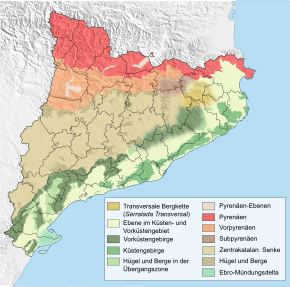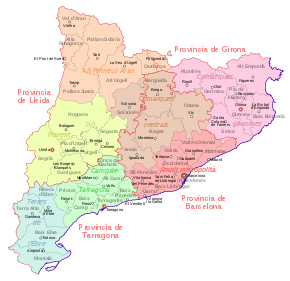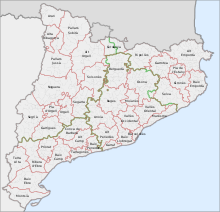Catalonia
![]()
The title of this article is ambiguous. For other meanings, see Catalonia (disambiguation).
Catalonia (Catalan Catalunya [kətəˈluɲə], Spanish Cataluña [kataˈluɲa], Aranese Catalonha [kataˈluɲa]) is a region in northeastern Spain between the Mediterranean coast and the Pyrenees.
Politically, Catalonia is one of 17 autonomous communities in Spain and is considered one of the "historical autonomous communities" (nacionalidades históricas in Spanish), along with the Basque Country and Galicia, due to historical and cultural characteristics. Independence efforts have gained great importance in Catalonia: Following a controversial referendum, the Catalan regional parliament declared Catalonia a republic independent of Spain on 27 October 2017 (the effectiveness of which was suspended by the president of the Generalitat himself), which was not recognized by the international community. The Spanish government declared this not to be legally valid, then deposed the regional government and parliament; since the new elections to the regional parliament on 21 December 2017, a separatist-dominated government has again ruled Catalonia, so that the Catalonia crisis continues to simmer and largely determine political events in Spain.
The capital of the region is Barcelona. The inhabitants are called Catalans. The official languages are Catalan and Spanish and Aranese.
Geography
Catalonia borders France and Andorra to the north, separated by the Pyrenees, the autonomous region of Aragon to the west and the region of Valencia to the southwest. The highest elevation is the 3143-meter-high Pica d'Estats, a peak of the Montcalm massif. Catalonia also includes the exclave of Llívia, which is surrounded by French territory.
With 32091 km² of land area, the autonomous community is about the size of Belgium. Although it covers only 6.3% of Spain's land mass, it has a population density of 234 inhabitants per square kilometre, 15.9% of Spain's population, almost nine times as dense as the neighbouring region of Aragon, and almost three times (2.8 times) as dense as the rest of Spain.
Topography
The territory of Catalonia can be divided geomorphologically into nine zones:
Catalan Pyrenees
The high mountain region of the Pyrenees (Pirineus in Catalan) occupies a strip of Catalonia located in the extreme north, on the border with France and Andorra. Here are several peaks of more than 3000 m height, the Pic de Sotllo (3084 m), Pic de Comaloforno (3033 m), Besiberri Nord (3015 m) and the highest elevation of Catalonia, the Pica d'Estats (3143 m). The rivers Noguera Pallaresa, Noguera Ribagorzana, Garona, Llobregat, Ter, and Muga also have their source in this region. The Pyrenees also include the Serra de l'Albera mountain range, located between the town of La Jonquera and the Mediterranean Sea, with the highest peak, Puig Neulós (1245 m).
See also: List of mountains in the Pyrenees
Catalan Pre-Pyrenees
The Pre-Pyrenees (Prepirineus in Catalan) form a mountainous strip about 20-45 km wide south of the Pyrenees, between Aragon in the west and the comarca of Garrotxa in the east. In this region are the mountain ranges Serra del Montsec, Serra de Boumort, el Port de Comte and el Cadí. In the pre-Pyrenees there are only a few peaks of more than 2000 m height. The highest peaks, such as Pedraforca (2497 m) and Torreta de Cadí (2561 m), are located in the Serra del Cadí.
Serralada Transversal
The largest area of this mountain range is occupied by the comarca of Garrotxa, with smaller parts in the neighbouring comarcas of Osona, Selva and Gironès. In the northwestern part of the Serrelada Transversal are the Serra de Milany and Serra de Santa Magdalena, they form a transition to the Pyrenees. To the northeast, the range borders the Fluvià River, and to the south, the Ter River forms a natural border with the Guilleries, part of the Catalan Precoastal Mountains. The Garrotxa volcanic area is also part of the mountain range. The highest point is Milany (1526 m).
Central Catalan Basin
The Central Catalan Depression (Depressió Central in Catalan) is a fertile plateau between 200 and 500 meters interspersed with isolated mountain ranges. The plain is bordered to the north by the Pre-Pyrenees, to the east by the Serralada Transversal, to the southwest by the Catalan Precoastal Mountains and to the west by the Autonomous Community of Aragon. The plains of Urgell (Plana de Urgell), Vic (Plana de Vic) and Bages (Pla de Bages), the basin of Barbarà (Conca de Barbarà), are part of this depression.
Massive
Individual, isolated elevations or mountain ranges of 800 to 1000 metres protrude as massifs from the Central Catalan Depression.
Catalan precoastal mountains
The Catalan Precoastal Mountains (Serralada Prelitoral Catalana in Catalan) is a non-contiguous low mountain range along the coastline, at a distance of 30 to 60 kilometres. The best known ranges are the Guilleries, Montseny, Sant Llorenç del Munt, Montserrat, Montsant, Muntanyes de Prades, Serra de l'Obac, Ports de Tortosa-Beseit and Serra del Montsià.
Catalan coastal mountains
The Catalan Coastal Mountains (Serralada Litoral Catalana in Catalan) is a non-contiguous low mountain range directly on the coast, between the Gulf of Roses and the river Foix. The mountain ranges from northeast to southwest: Massís del Montgrí, Massís de les Gavarres, Serra del Montnegre, Serra del Corredor, Serra de Marina, Serra de Collserola and Massís del Garraf.
Coastal Plain
The coastal plain (Catalan: Depressió Litoral) lies directly on the Mediterranean coast.
Precoastal
The precoastal plain (Depressió Prelitoral in Catalan) is a plain close to the coast or behind the coastal mountains.
Cities
Important cities besides Barcelona are Tarragona, Lleida and Girona, as well as Manresa, Vic, Igualada, Martorell, Figueres, Reus, Mataró, Terrassa and Sabadell. L'Hospitalet, Badalona and Santa Coloma de Gramenet, also large cities, directly border Barcelona and belong to its agglomeration.
See also: List of the largest cities in Catalonia
Coast
The coastline of about 580 km in length is varied and in the north on the rocky Costa Brava characterized by numerous sandy small bays, the Calas, while in the south on the Costa Daurada wide sandy beaches predominate. In between, north of Barcelona lies the Costa del Maresme and south of Barcelona the Costa del Garraf.
Nature Parks
Catalonia is home to some of the most important nature reserves in the Iberian Peninsula. These include the Aigüestortes i Estany de Sant Maurici National Park in the Pyrenees to the northwest, the Volcanoes of the Garrotxa Nature Reserve in the foothills of the Pyrenees to the northeast, the Ebro Delta Nature Reserve to the south, and the Cap de Creus Nature Reserve at the easternmost point of the Iberian Peninsula. The Montseny Nature Park has also been designated a Biosphere Reserve by UNESCO.
The natural parks are managed, for example, within the framework of the Xarxa de Parcs Naturals ('Natural Parks Network') of the Diputació de Barcelona ('Barcelona Provincial Council').

Map of the geomorphology in Catalonia: Pyrenees Subpyrenees Subpyrenees Precoastal mountains Coastal mountains Precoastal/Coastal Plain Plains in the Pyrenees Massive Transversal mountain range (Serralada Transversal) Central Catalan Depression
Political division
Catalonia is administratively divided into provinces, comarques and municipalities. In the future, the vegueries are to take the place of the provinces.
Provinces/vegueries
Since 1833, Catalonia has had four provinces: Barcelona, Tarragona, Lleida and Girona. According to the Statute of Autonomy of 2006 and the Catalan Regional Law (Llei 30/2010, del 3 d'Agost, de vegueries of 3 August 2010), seven so-called vegueries are to replace the provinces. However, since according to the Spanish Constitution a change in provincial boundaries can only be made by an organic law of the Cortes Generales, i.e. the Spanish Parliament in Madrid, the seven vegueries provided for in the regional law (L'Alt Pirineu, Barcelona, La Catalunya Central, Girona, Lleida, El Camp de Tarragona, Les Terres del Ebre) will only be established once the corresponding legislative changes have been made at state level. At present, it is not foreseeable if and when this will happen, so that the division into four provinces will remain in place for the foreseeable future.
However, the jurisdictions of the authorities of the administrative substructure of the Autonomous Community are already partly based on the territorial status of the future vegueries, while those of the state authorities are based on those of the four provinces.
The Val d'Aran, which has a special status, will initially be part of the vegueria L'Alt Pirineu and will only later be completely removed from this level of division (although this will also require legislative changes at the Spanish level).
Comarques
As early as 1936, the then Catalan autonomous government issued a decree dividing the territory into comarques. However, with the beginning of Franco's dictatorship after the defeat of republican troops in the Spanish Civil War, this decree was repealed.
In 1987, 12 years after the death of Franco and the transition to democracy, a regional law in Catalonia re-established the pre-Franquist comarques. However, the number of these 38 "old" comarques was expanded or modified by three more, so that in 1988 a total of 41 comarques were established as municipal associations. A reform in 2015 established a 42nd comarca, the Moianès.
The borders are not always aligned with the provincial borders, i.e. there are several comarques to which municipalities of different provinces belong. This is to change with the replacement of the provinces by the vegueries, each of which will encompass the territory of several comarques. In terms of size, the comarques are comparable to administrative districts in Germany.
Communities
Catalonia is divided into 946 municipalities.
- List of municipalities in the province of Barcelona
- List of municipalities in the province of Girona
- List of municipalities in the province of Lleida
- List of municipalities in the province of Tarragona

Division of Catalonia into four provinces and the seven territories (àmbits funcionals territorials) with the comarques. Provincial borders territories: Alt Pirineu i Aran Comarques gironines Comarques Centrals Àmbit Metropolità de Barcelona Ponent Camp de Tarragona Terres de l'Ebre

The 42 Comarques of Catalonia

The four provinces of Catalonia
Search within the encyclopedia